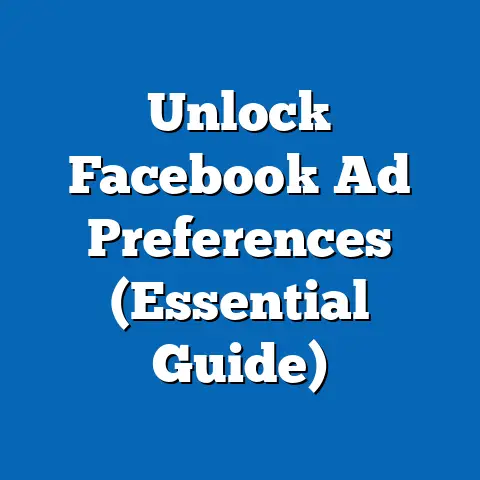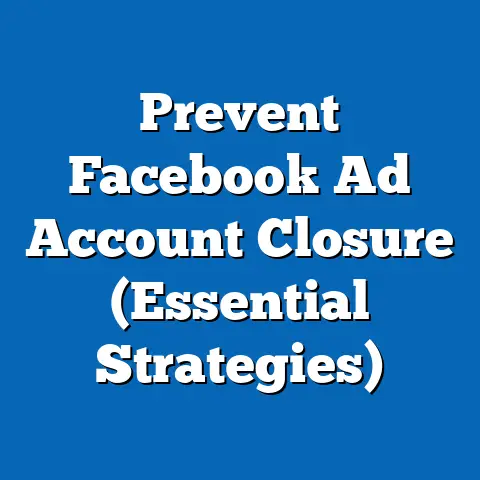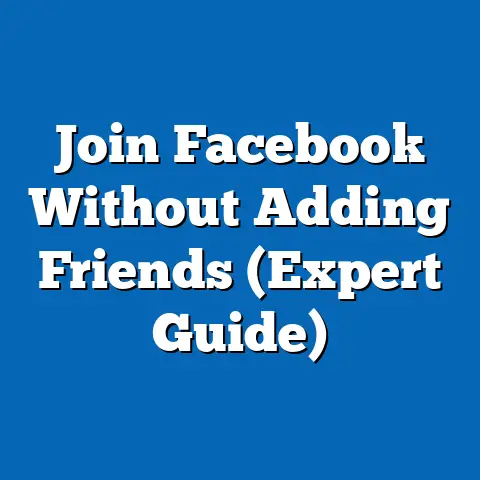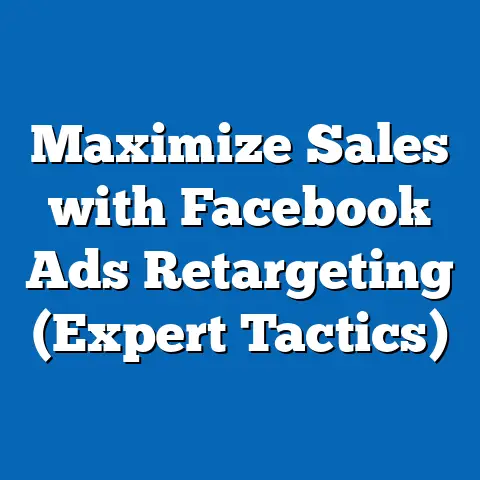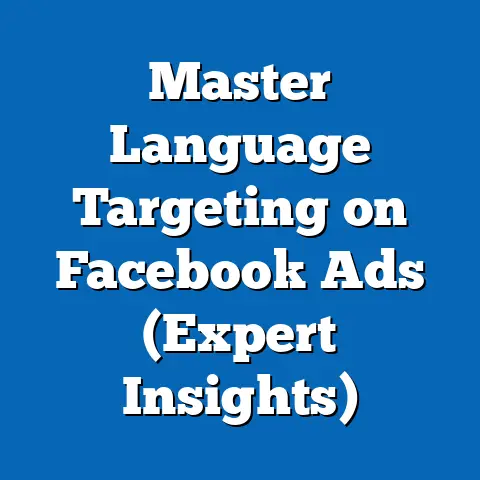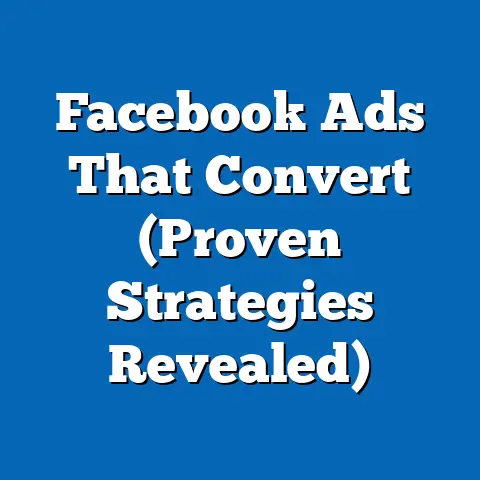Master Facebook Campaigns for 2025 (Strategic Game Plan)
The digital marketing landscape is in constant flux. What worked yesterday might be obsolete tomorrow, and nowhere is this more apparent than in the world of social media advertising. Facebook, a giant in this arena, is perpetually evolving. As we approach 2025, businesses need to brace themselves for significant shifts in algorithms, user behavior, and ad formats. Ignoring these changes is like sailing a ship without a rudder – you’re destined to drift aimlessly, wasting valuable resources. If you want to truly thrive, you need a strategic game plan.
According to Statista, Facebook boasts nearly 3 billion monthly active users as of the latest data, making it an undeniable powerhouse for reaching potential customers. However, with this vast audience comes intense competition. Ad prices are rising, and users are becoming more discerning. Failing to adapt means your message gets lost in the noise. Let’s dive into the strategic game plan you need to win.
Understanding the Facebook Ad Landscape for 2025
The Facebook advertising landscape is a dynamic entity, shaped by technological advancements, evolving user preferences, and shifts in the broader digital ecosystem. I’ve seen it transform from a relatively simple platform to a sophisticated advertising machine. To prepare for 2025, we need to understand where we are now and where we’re headed.
As of October 2023, we’re seeing a strong emphasis on video content, personalized advertising experiences, and the increasing importance of mobile optimization. Facebook is also cracking down on data privacy, which has implications for ad targeting and measurement.
Looking ahead, several key trends are likely to shape the Facebook ad landscape in 2025:
- Increased Competition: As more businesses flock to Facebook to reach their target audiences, ad space becomes increasingly competitive, driving up costs and making it harder to stand out from the crowd.
- Shifts in User Demographics: Facebook’s user base is aging, and younger generations are gravitating towards other platforms like TikTok and Instagram. This means businesses need to refine their targeting strategies to reach the right audience on Facebook.
- Evolving Consumer Expectations: Consumers are becoming more demanding and expect personalized, relevant, and engaging advertising experiences. Generic, irrelevant ads are likely to be ignored or even resented.
- AI-Powered Advertising: Artificial intelligence (AI) is already playing a significant role in Facebook advertising, and its influence is only going to grow in the coming years. AI-powered tools can help businesses automate ad creation, optimize targeting, and improve campaign performance.
- Data Privacy Regulations: Data privacy regulations like GDPR and CCPA are forcing Facebook to limit the amount of data it collects and shares with advertisers. This means businesses need to find alternative ways to target and personalize their ads, such as using first-party data and contextual targeting.
These changes will fundamentally alter how brands interact with their audiences on Facebook. Businesses that fail to adapt will find it increasingly difficult to achieve their advertising goals.
Key Takeaway: The Facebook advertising landscape is constantly evolving. To succeed in 2025, businesses need to stay informed about emerging trends and adapt their strategies accordingly.
Strategic Foundations for Successful Facebook Campaigns
A successful Facebook advertising campaign isn’t just about creating a pretty ad and hoping for the best. It requires a solid strategic foundation built on a clear understanding of your business goals, target audience, and the customer journey. I’ve seen many businesses launch campaigns without a clear strategy, and the results are almost always disappointing.
Here are the key components of a successful Facebook advertising strategy:
- Defining Clear Goals: What do you want to achieve with your Facebook campaigns? Are you trying to increase brand awareness, generate leads, drive sales, or something else? Your goals will influence your campaign structure, ad creative, and targeting strategy. I always advise clients to use the SMART framework (Specific, Measurable, Achievable, Relevant, Time-bound) to define their goals.
- Audience Research: Who are you trying to reach with your ads? What are their demographics, interests, and behaviors? The more you know about your target audience, the better you’ll be able to create ads that resonate with them. Facebook’s Audience Insights tool is a great resource for conducting audience research.
- Audience Segmentation and Targeting: Once you understand your target audience, you need to segment them into smaller groups based on their characteristics and behaviors. This allows you to create more targeted ads that are relevant to each group. Facebook offers a wide range of targeting options, including demographic targeting, interest targeting, behavioral targeting, and custom audiences.
- The Marketing Funnel: The marketing funnel is a visual representation of the customer journey, from initial awareness to final purchase. Understanding the marketing funnel is essential for creating Facebook campaigns that are aligned with each stage of the customer journey. For example, you might use awareness campaigns to reach new audiences, lead generation campaigns to capture contact information, and conversion campaigns to drive sales.
- Budget Allocation: How much money are you willing to spend on your Facebook campaigns? How will you allocate your budget across different objectives and ad sets? It’s important to set a realistic budget and allocate your funds effectively to maximize your ROI.
By laying a solid strategic foundation, you’ll be well-positioned to create Facebook campaigns that achieve your business goals and deliver a positive return on investment.
Key Takeaway: A well-defined strategy is essential for successful Facebook campaigns. Take the time to research your audience, define your goals, and align your campaigns with the customer journey.
Crafting Compelling Ad Content
In the crowded landscape of Facebook, your ad has mere seconds to capture attention and convey your message. I’ve learned that compelling ad content is the key to breaking through the noise and engaging your target audience. This means creating visuals, copy, and calls-to-action that resonate with your audience and inspire them to take action.
Here are some tips for crafting compelling Facebook ad content:
- Eye-Catching Visuals: Your ad’s visual is the first thing people will see, so it needs to be attention-grabbing and relevant to your message. Use high-quality images or videos that are visually appealing and accurately represent your brand. Consider using bright colors, bold fonts, and interesting compositions to make your ad stand out.
- Compelling Copy: Your ad copy should be clear, concise, and persuasive. Highlight the benefits of your product or service and explain why people should choose you over the competition. Use strong verbs and compelling language to create a sense of urgency and excitement.
- Strong Calls-to-Action: Your call-to-action (CTA) tells people what you want them to do after seeing your ad. Use clear and concise CTAs that are relevant to your campaign objective. For example, if you’re trying to generate leads, you might use a CTA like “Sign Up Now” or “Get a Free Quote.” If you’re trying to drive sales, you might use a CTA like “Shop Now” or “Buy Now.”
- Storytelling: People are more likely to connect with ads that tell a story. Use storytelling to create an emotional connection with your audience and make your brand more relatable. Share customer testimonials, case studies, or behind-the-scenes glimpses of your business.
- A/B Testing: Don’t be afraid to experiment with different ad formats, visuals, and copy to see what resonates best with your audience. A/B testing allows you to compare different versions of your ad and identify the elements that are driving the best results. Facebook’s Ads Manager makes it easy to run A/B tests and track your results.
Remember, the key to crafting compelling ad content is to understand your target audience and create ads that are relevant, engaging, and persuasive.
Key Takeaway: Compelling ad content is essential for capturing attention and engaging your target audience. Use high-quality visuals, compelling copy, and strong calls-to-action to create ads that resonate with your audience and inspire them to take action.
Budgeting and Bidding Strategies
Even the most creative and well-targeted ad will fall flat if it’s not backed by a sound budgeting and bidding strategy. I’ve seen businesses waste a lot of money on Facebook advertising by simply throwing money at the platform without a clear understanding of how to allocate their budget and optimize their bids.
Here are some budgeting and bidding best practices for Facebook campaigns:
- Set a Realistic Budget: Determine how much you’re willing to spend on your Facebook campaigns based on your business goals and financial resources. It’s important to set a realistic budget that allows you to reach your target audience and achieve your desired results.
- Allocate Your Budget Effectively: Allocate your budget across different objectives and ad sets based on their potential to generate results. For example, you might allocate a larger portion of your budget to conversion campaigns if your primary goal is to drive sales.
- Choose the Right Bidding Strategy: Facebook offers several bidding strategies, including cost-per-click (CPC), cost-per-impression (CPM), and cost-per-action (CPA). The right bidding strategy will depend on your campaign goals and the level of competition in your target audience.
- Cost-Per-Click (CPC): You pay each time someone clicks on your ad. This is a good option if you’re trying to drive traffic to your website or landing page.
- Cost-Per-Impression (CPM): You pay for every 1,000 impressions of your ad. This is a good option if you’re trying to increase brand awareness.
- Cost-Per-Action (CPA): You pay only when someone takes a specific action, such as making a purchase or filling out a form. This is a good option if you’re trying to generate leads or drive sales.
- Monitor Your Spending: Use the Facebook Ads Manager to monitor your spending and track your performance metrics. This will allow you to identify areas where you can optimize your budget and improve your ROI.
- Adjust Your Bids in Real Time: Based on your performance data, adjust your bids in real time to maximize your results. For example, if you’re seeing a high click-through rate (CTR) but a low conversion rate, you might want to lower your bids to reduce your costs.
- Cost-Per-Click (CPC): You pay each time someone clicks on your ad. This is a good option if you’re trying to drive traffic to your website or landing page.
- Cost-Per-Impression (CPM): You pay for every 1,000 impressions of your ad. This is a good option if you’re trying to increase brand awareness.
- Cost-Per-Action (CPA): You pay only when someone takes a specific action, such as making a purchase or filling out a form. This is a good option if you’re trying to generate leads or drive sales.
By following these budgeting and bidding best practices, you can ensure that you’re getting the most out of your Facebook advertising spend.
Key Takeaway: A well-planned budgeting and bidding strategy is essential for maximizing your ROI on Facebook advertising. Set a realistic budget, allocate your funds effectively, choose the right bidding strategy, and monitor your spending closely.
Measuring and Optimizing Campaign Performance
Launching a Facebook campaign is just the first step. The real work begins when you start measuring and optimizing your campaign performance to ensure you’re achieving your goals. I’ve seen many businesses launch campaigns and then simply forget about them, without ever tracking their results or making adjustments. This is a recipe for wasted ad spend.
Here are the key performance indicators (KPIs) that businesses should track to evaluate the success of their Facebook campaigns:
- Reach: The number of unique people who saw your ad.
- Impressions: The number of times your ad was displayed.
- Click-Through Rate (CTR): The percentage of people who clicked on your ad after seeing it.
- Conversion Rate: The percentage of people who took a desired action after clicking on your ad, such as making a purchase or filling out a form.
- Cost-Per-Click (CPC): The average cost you paid for each click on your ad.
- Cost-Per-Action (CPA): The average cost you paid for each desired action taken after clicking on your ad.
- Return on Ad Spend (ROAS): The amount of revenue you generated for every dollar you spent on advertising.
Use Facebook Analytics and other reporting tools to gain insights into audience engagement and campaign effectiveness. These tools can provide valuable data on demographics, interests, and behaviors of your target audience, as well as the performance of your ads.
Here are some actionable tips for optimizing campaigns based on performance data:
- Adjust Your Targeting: If you’re not reaching the right audience, adjust your targeting criteria to narrow your focus.
- Refine Your Ad Creative: If your ads aren’t generating enough clicks or conversions, try experimenting with different visuals, copy, and calls-to-action.
- Optimize Your Bidding Strategy: If you’re paying too much for clicks or conversions, adjust your bidding strategy to lower your costs.
- Pause Underperforming Ads: If certain ads are consistently underperforming, pause them to avoid wasting your budget.
- Test New Ad Formats: Experiment with different ad formats to see what resonates best with your audience.
By continuously measuring and optimizing your campaign performance, you can ensure that you’re getting the most out of your Facebook advertising spend and achieving your business goals.
Key Takeaway: Measuring and optimizing campaign performance is essential for maximizing your ROI on Facebook advertising. Track your KPIs, analyze your data, and make adjustments to your targeting, creative, and bidding strategies.
Conclusion
The world of Facebook advertising is a dynamic and ever-changing landscape. As we approach 2025, businesses must adapt to the evolving algorithms, user behaviors, and ad formats to stay ahead of the competition. This strategic game plan provides you with the tools and knowledge to master Facebook campaigns in the face of these changes.
Remember the key takeaways:
- Understand the evolving landscape: Stay informed about emerging trends and adapt your strategies accordingly.
- Build a solid strategic foundation: Research your audience, define your goals, and align your campaigns with the customer journey.
- Craft compelling ad content: Use high-quality visuals, compelling copy, and strong calls-to-action.
- Optimize your budgeting and bidding: Set a realistic budget, allocate your funds effectively, and choose the right bidding strategy.
- Measure and optimize performance: Track your KPIs, analyze your data, and make adjustments to improve your results.
By implementing this strategic game plan, you can seize the opportunity to lead in the Facebook advertising space and achieve your business goals in 2025 and beyond. The future of Facebook advertising is bright, and with the right strategies in place, you can harness its power to drive growth and success for your business. Now is the time to take action, refine your approach, and prepare to dominate the Facebook advertising landscape in the years to come. Don’t be a passive observer – become a proactive leader!

